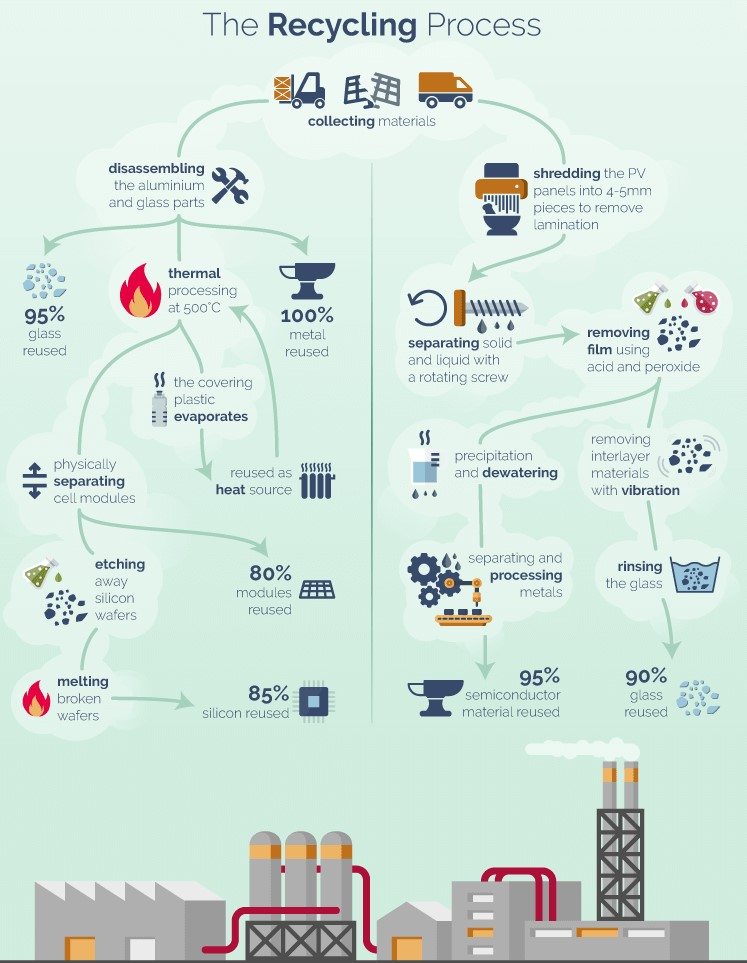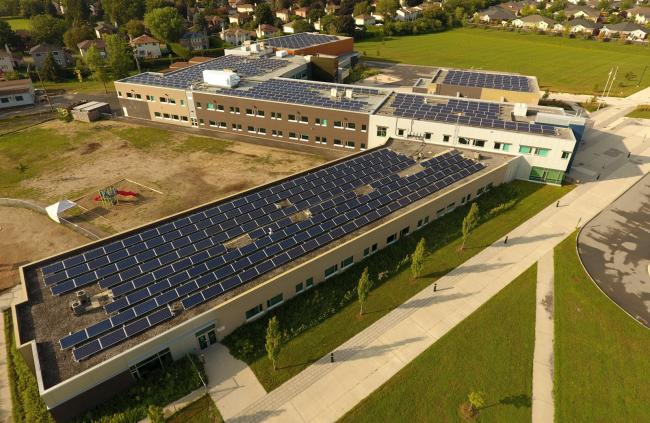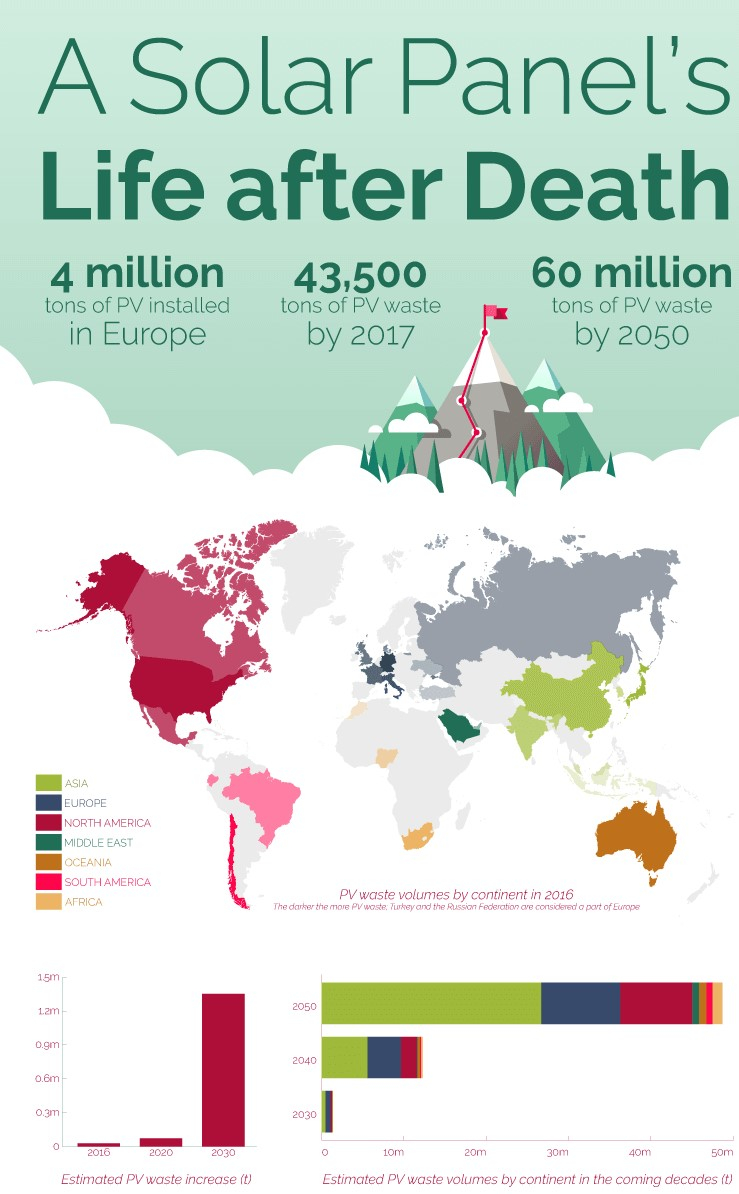In British Columbia, municipalities have asked for more products to be added to the recycling regulations, said Sue Maxwell, a director with Zero Waste BC.
A policy intentions paper published by the B.C. Ministry of Environment and Climate Change Strategy in September acknowledged that solar panels can be recycled, but said “producers need to establish collection and recycling programs for homeowners and communities, particularly rural and remote, that otherwise will have limited options to divert from disposal.”
The overall environmental impact of solar panels is much higher if they are dumped in landfills, where hazardous chemicals and heavy metals can leach into groundwater.
This was recognized in a 2010 report by Natural Resources Canada and Environment Canada. It noted the relative newness of solar installations in 2010 and their long lifespans meant there was “very little experience with or knowledge of the disposal or recycling of PV modules.”
Solar panel recycling is challenging. It is difficult to separate raw materials such as glass, aluminum and the rare and valuable materials (including tellurium, iridium and gallium) used to construct the modules.
“Failing to reclaim these materials through recycling contributes to resource depletion,” the report noted.
A decade later, that knowledge gap persists, despite the report also warning that increased production of photovoltaics raises the need to monitor the environmental and health impact of “hazardous materials such as lead, brominated flame retardants and hexavalent chromium.”
For now, the only solar panel recycling options available for Canadians lie outside the country.
Like Canada, the U.S. used to transport solar panels to other countries for recycling. However, a partnership between American and European industry associations, Recycle PV and PV Cycle, enabled the rapid development of nationwide solar panel recycling. In August 2018, Recycle PV opened the first dedicated solar panel recycling facility in the U.S.
Incentivizing solar panel recycling
Solar panel design makes disassembly difficult and costly, disincentivizing the recovery of raw materials from dead panels. Refurbishment is also unappealing in Canada because technological advances make older panels highly inefficient by today’s standards.
Maxwell thinks Canada could learn from the European Union, where there are “funds or tax incentives for repair/reuse/refurbishment, Right to Repair and mandatory warranty laws, policies to encourage sharing, policies to minimize new fossil fuel infrastructure, and bans on further harmful products and materials.”
Ideally, recycling incentives are built into the panel, so that the cost is borne and recouped by the producer rather than the consumer. This is the basis of EPR and the idea behind Washington state’s new solar stewardship program, set to take effect in January. The program requires manufacturers to take back panels sold after July 2017 for recycling at no cost to consumers.
EPR regulations aim to prevent waste, and done correctly, can promote a more sustainable, circular economy. When forced to pay to recycle their own panels, manufacturers are incentivized to design them to be easy and inexpensive to take apart and develop processes to reclaim materials for reuse.
The Washington stewardship program could offer a framework for Canadian policy-makers developing regulations for photovoltaic decommissioning. But many EPR programs in Canada, the U.S. and the EU are “convoluted,” according to Josh Lepawsky, professor of geography at Memorial University and author of Reassembling Rubbish: Worlding Electronic Waste.
Despite how they’re portrayed, “ultimately, consumers pick up the tab of recycling electronics,” he said.
“Recycling rules and regulations are written by non-profit industry associations, then adopted by governments who mandate things like ‘eco-fees’ or ‘advance disposal fees’ collected at the time of consumer purchase of devices,” Lepawsky said.
These fees help fund recycling infrastructure, but ultimately, “the costs of running those systems are kept away from the bottom line of original equipment manufacturers and brands. That is the exact opposite of what EPR is supposed to achieve.”

Image by GreenMatch, 2017
Investment in recycling infrastructure is important, and regulations like EPR could help promote greater adoption of high-value recycling. This is something First Solar Inc. is trying to develop to establish “circularity in the PV value chain.” The U.S.-based photovoltaics company has a large presence in Canada, having established at least three of Canada’s largest solar farms.
First Solar recovers “over 90 per cent of the semiconductor and 90 per cent of the glass from end-of-life panels to proactively reduce our life cycle environmental footprint,” according to Andreas Wade, First Solar’s director of global sustainability.
A new high-value electrochemical recycling process that extracts purer metals from solar cells could help make recycling lucrative rather than a financial burden for manufacturers. The development of this process is being led by Meng Tao, professor and Fulbright Distinguished Chair in Alternative Energy Technology. Tao said that “with sufficient funding, we are almost ready to deploy a prototype solar recycling line.”
The International Renewable Agency (IRENA) estimates that $15 billion could be recovered from recycling solar panels by 2050.
Lessons from Europe
As of Feb. 14, 2014, the EU banned electronic products, including solar panels, from going to landfills, but the EU has been recycling solar panels for far longer. PV Cycle, a European solar panel recycling industry association, estimates its members have recycled 17,000 metric tonnes of photovoltaics since 2010.
“In Europe, they got recycling because the industry associations co-operated and actually spun it out of the industry association,” said Dustin Mulvaney, a professor in the environmental studies department at San Jose State University. He added that they “only did that because they were going to be regulated ... In the United States, (the) industry association has done everything (it) can to stick branches in the spokes of regulation. This policy does not work without regulation.”
In 2012, the EU created a specific policy directive to manage solar panel waste in every EU country. The WEEE (Waste Electrical and Electronic Equipment) Directive requires companies operating in the EU to manufacture solar panels in a sustainable manner and to take back and properly dispose of all panels sold after August 2005.
The number of solar panels reaching end of life in Europe doubles every year; 35,000 metric tonnes of solar panel e-waste is expected in 2020 alone. The good news is that the industry has recycling rates of up to 90 per cent for silicon-based modules and up to 97 per cent for non-silicon-based modules.
In 2018 in Rousset, the French water and waste group Veolia opened Europe’s first dedicated solar panel recycling facility in partnership with PV Cycle. Here, robots disassemble solar panels and recover component materials such as glass, aluminum, silicon and copper for reuse.
Veolia aims to create the capacity to recycle 4,000 tonnes of panels by 2022 and all decommissioned panels in France shortly thereafter.
Solar panel recycling in Canada
In Canada, solar panel recycling options rest primarily on Dynamic Lifecycle Interventions, which has locations in four provinces. The company collects defunct solar panels and ships these to recycling facilities in the U.S.
In October 2010, the Sarnia Photovoltaic Power Plant went online, becoming the largest solar farm in the world, with the capacity to power up to 12,000 homes. A decade later — nearly halfway through the panels’ lifespan — Canada has no capacity to safely decommission and recycle the 1.3 million solar modules when they stop working.
Sarnia is a First Solar installation subsequently sold to Enbridge. First Solar owns at least three solar farms in Ontario and initially offered unconditional recycling of its modules through a takeback policy. Modules covered under that historical policy are still eligible for free recycling through First Solar. The company has since transitioned to an optional end-of-life payment for recycling with First Solar or an alternative recycling vendor.
First Solar has no recycling facilities in Canada and instead ships modules to the U.S. or Malaysia for recycling. Wade said a standalone recycling facility in Canada is not yet viable. However, First Solar has “recycled over 2,000 metric tonnes of end-of-life PV modules from Canadian installations in our recycling facility in Perrysburg, Ohio — which is about 60 minutes away from Windsor, Ont.,” he said.
Wade added: “We co-locate our current recycling facilities with our manufacturing operations since the majority of what we recycle today is manufacturing scrap.”
First Solar is also investigating the potential for mobile recycling units, which will become more viable as larger volumes of PV modules start to be decommissioned.
The future of solar panel recycling in Canada
On Nov. 19, Canada laid out legislation aiming to achieve net-zero greenhouse gas emissions by 2050. Renewable energy sources, including wind and solar, are key parts of this net-zero strategy, but this push for renewables is unsustainable without regulations governing hazardous e-waste, resource extraction, and recycling to reclaim raw materials for reuse.
By 2050, Canada is expected to produce 650,000 tonnes of solar panel waste. Right now, Canada has no capacity to recycle the 350 tonnes produced in 2016 alone.
Although experts agree that decommissioning requires urgent attention, it is during resource extraction and manufacturing that the greatest opportunities lie for reducing hazardous waste production.
This is one of Lepawsky’s key criticisms of e-waste discussions. By thinking of e-waste only at the household level, “substantial effort is directed toward attempting to change what happens at the end of the pipe instead of toward changing what comes down the pipe in the first place,” Lepawsky said.
If the e-waste problem is only addressed post-purchase, “consumers — who are least able to effect significant change — will bear the burden of responsibility.”



